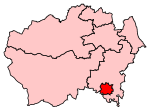North Road railway station
Buildings and structures in DarlingtonDfT Category F2 stationsFormer North Eastern Railway (UK) stationsGrade II* listed buildings in County DurhamGrade II* listed railway stations ... and 8 more
Northern franchise railway stationsPages with no open date in Infobox stationRailway stations in Great Britain closed in 1842Railway stations in Great Britain opened in 1825Railway stations in Great Britain opened in 1842Railway stations in the Borough of DarlingtonStockton and Darlington RailwayUse British English from December 2016

North Road is a railway station on the Tees Valley Line, which runs between Bishop Auckland and Saltburn via Darlington. The station, situated 1 mile 23 chains (2.1 km) north-west of Darlington, serves the market town of Darlington in County Durham, England. It is owned by Network Rail and managed by Northern Trains.
Excerpt from the Wikipedia article North Road railway station (License: CC BY-SA 3.0, Authors, Images).North Road railway station
Bonomi Way,
Geographical coordinates (GPS) Address External links Nearby Places Show on map
Geographical coordinates (GPS)
| Latitude | Longitude |
|---|---|
| N 54.5356878 ° | E -1.5537227 ° |
Address
North Road
Bonomi Way
DL3 6ST , Hopetown
England, United Kingdom
Open on Google Maps









